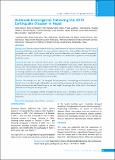Please use this identifier to cite or link to this item:
https://hdl.handle.net/20.500.14356/1601Full metadata record
| DC Field | Value | Language |
|---|---|---|
| dc.contributor.author | Shakya, Geeta | - |
| dc.contributor.author | Marasini, Baburam | - |
| dc.contributor.author | Karki, Khem Bahadur | - |
| dc.contributor.author | Upadhaya, Bishnu Prasad | - |
| dc.contributor.author | Acharya, Jyoti | - |
| dc.contributor.author | Adhikari, Shailaja | - |
| dc.contributor.author | Manjhi, Rosham | - |
| dc.contributor.author | Maharjan, Laxman | - |
| dc.contributor.author | Shrestha, Lilee | - |
| dc.contributor.author | Ranabhat, Kamal | - |
| dc.contributor.author | Marahatta, Sujan Babu | - |
| dc.contributor.author | Shrestha, Bikal | - |
| dc.contributor.author | Dhimal, Meghnath | - |
| dc.date.accessioned | 2023-05-16T08:02:27Z | - |
| dc.date.available | 2023-05-16T08:02:27Z | - |
| dc.date.issued | 2018 | - |
| dc.identifier.citation | ShakyaG., MarasiniB., KarkiK. B., UpadhayaB. P., AcharyaJ., AdhikariS., ManjhiR., MaharjanL., ShresthaL., RanabhatK., MarahattaS. B., ShresthaB., & DhimalM. (2018). Outbreak Investigation Following the 2015 Earthquake Disaster in Nepal. Journal of Nepal Health Research Council, 16(1), 61-65. https://doi.org/10.33314/jnhrc.v16i1.1365 | en_US |
| dc.identifier.issn | Print ISSN: 1727-5482; Online ISSN: 1999-6217 | - |
| dc.identifier.uri | http://103.69.126.140:8080/handle/20.500.14356/1601 | - |
| dc.description | Original Article | en_US |
| dc.description.abstract | Abstract Background: Infectious disease outbreaks following natural disasters are reported in literature. Outbreaks were documented following natural disasters in many countries including Haiti. Such possibility following 2015 Nepal earthquake was a public health concern. Risk factors needed evaluation by post-disaster outbreak investigation. Hence, present study was undertaken to investigate potentials for such outbreak and to generate evidence for public health intervention. Methods: The study was conducted between April – May, 2015, with the cooperation of National Public Health Laboratory, Epidemiology and Disease Control Division, Nepal Health Research Council and the Chinese team. Rapid Response Teams visited earthquake affected districts and collected samples for analysis. Syndromic surveillance approach was followed. Samples were collected from syndromic patients under supervision. Those sick prior to earthquake or receiving treatment were excluded. Blood, stool and throat swab samples, as indicated, were collected. Drinking water and food samples including captured live mosquitoes from inhabited areas were obtained for study with the help of EDCD. Laboratory analysis was performed at the NPHL. Results: Total samples were 360 (114 biological, 246 environmental). Salmonella spp. was detected in two and Varicella zoster in one blood sample. Influenza B virus was detected in one throat swab. Rota virus was detected in two, Shigella dysenteriae in one and Salmonella spp. in one stool sample. No pathogen detected in water or food samples. Mosquitoes tested negative for dengue virus. Conclusions: Post-earthquake outbreak investigated in disaster phase-2. Diarrheal, enteric fever pathogens and Influenza B virus were detected. Environmental samples tested negative for pathogens. Vigilance is necessary for other risk factors. | en_US |
| dc.language.iso | en_US | en_US |
| dc.publisher | Nepal Health Research Council | en_US |
| dc.relation.ispartofseries | Jan - Mar 2018;1365 | - |
| dc.subject | Investigation | en_US |
| dc.subject | Natural disaster | en_US |
| dc.subject | Outbreaks | en_US |
| dc.title | Outbreak Investigation Following the 2015 Earthquake Disaster in Nepal | en_US |
| dc.type | Journal Article | en_US |
| local.journal.category | Original Article | - |
| Appears in Collections: | Vol. 16 No. 1 Issue 38 Jan-Mar 2018 | |
Files in This Item:
| File | Description | Size | Format | |
|---|---|---|---|---|
| 1365-Manuscript-3919-3-10-20180315.pdf | Full text Article. | 223.61 kB | Adobe PDF |  View/Open |
Items in DSpace are protected by copyright, with all rights reserved, unless otherwise indicated.
